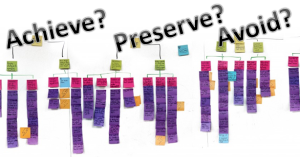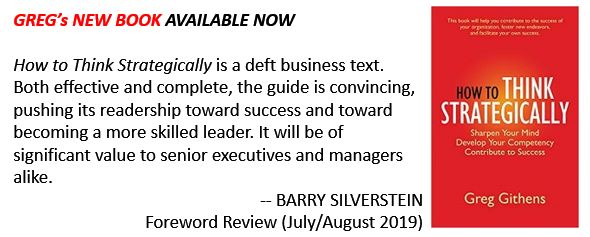 Strategy is inherently ambiguous, with goals and expectations differing depending upon the stakeholder. Because people tend to feel uncomfortable with ambiguity, a leader needs to clear the fog; a process that is best called gaining perspective. Before the leader can help others, s/he needs to clarify their her/his own view of the rewards and the risks. This article identifies three useful questions for gaining perspective*: What do I want to achieve? What do I want to preserve? What do I want to avoid? The following story illustrates their application.
Strategy is inherently ambiguous, with goals and expectations differing depending upon the stakeholder. Because people tend to feel uncomfortable with ambiguity, a leader needs to clear the fog; a process that is best called gaining perspective. Before the leader can help others, s/he needs to clarify their her/his own view of the rewards and the risks. This article identifies three useful questions for gaining perspective*: What do I want to achieve? What do I want to preserve? What do I want to avoid? The following story illustrates their application.
The New VP of Engineering’s Challenge
Let’s examine a strategic initiative at a mid-sized, closely-held manufacturer. A few words about company politics are necessary to establish the context for use of the three achieve-preserve-avoid questions.
David was the co-sponsor to the strategic initiative intended to improve new product development productivity. David saw this strategic initiative as an opportunity to assure the company’s growth and reputation as an innovator. David’s view (and I agreed with him) was that a holistic view – including a better and more proactive “voice of the customer” – would be beneficial. Also relevant: David was newly-promoted to the position of VP of Engineering.
The other co-sponsor was Frank, the VP of Sales, who had held the position for many years. Frank saw this strategic initiative as a problem to be solved: how do we fix things so that the company can respond to requests quicker and more effectively. He wanted the rest of the company to be more responsive to customer requirements, as presented by the sales department.
David asked me and Walter, a capable and trusted manager, to come to his office to help him think through the challenges. I moved to his white board and wrote the question, “What do we want to Achieve?” on the left side. I wrote, “What do we want to Preserve?” in the center and “What do we want to Avoid?” on the right side. I then gave them a set of sticky notes and instructed them to write out answers on sticky notes and post underneath the appropriate question. They went to work, and within 15 minutes they had posted several dozen answers.
We next started to look for conceptual relationships between the ideas written on the stickies. We moved the stickies around to show affinity relationships. This analysis sparked insightful discussions on benefits, risks, metrics, and stakeholder imperatives.
As we neared completion, I could see David’s confidence grow. The case for better business performance was there; we wanted to achieve that. We wanted to preserve friendly working relationships with the co-sponsor and other influencers. We wanted to avoid waste and rework, and we wanted to avoid missing out on the opportunities.
As I left the meeting, David thanked me for my help and shared that he was an elder in his church, and he would introduce the technique to their next strategic planning meeting.
The Strategic Initiative Delivers Benefits
Here is what happened with the strategic initiative. David was steadily able to deliver results and build a coalition of other managers to support the new approach. With David’s and Walter’s leadership the innovation process has shown steady progress, contributing to improved financial performance. However, David’s steady leadership eventually brought the CEO into a fuller appreciation of the benefits of the strategic initiative and the CEO became more willing to champion it.
Ideally, I would have through the same process with Frank. Frank never had much passion for anything other than his Sales functional perspective, so he withdrew from the role of co-sponsor. Earlier in the strategic initiative, Frank was opposed to many of David’s ideas and conflict loomed. Frank’s opposition was neutralized by David and Walter’s careful advocacy of the benefits.
From What is Best for Me to What is Best for All of Us
The first answers to the questions are typically self-centered, which is to be expected in a culture that is individualistic and competitive. A leader has to understand their own values and priorities before they can effectively lead others.
Next, we introduce and discuss the group’s perspective, “What is best for all of us?” Usually, the collective answer points towards important organizational performance gaps and the need for consensus to get the gaps closed.
Have can you apply these three questions and gain better perspective for your strategic initiative?
* I learned these three questions from John Arnold’s advice to new executives in his 1981 book, Shooting the Executive Rapids. Executives often parachute into high-pressure, high visibility situations where they need to close a performance gap or otherwise make significant changes; in other words, executives often come into organizations to launch or lead strategic initiatives.


Just recommend you to Atlanta chapter
Am at the Venice jetties , I sure miss this coast
John Sent from iPhone
Hi Greg, I just had to send you a note to let you know that I read this post and put the technique into action in a senior management team meeting where we are dealing with ambiguity. They totally responded to the simplicity of only 3 columns with 3 words; objectives emerged quite easily with this technique. I will definitely continue to use Achieve, Preserve, Avoid…..thank you so much! Val
Valerie Lothian PMP | Manager, Strategic Support | SaskCentral [cid:image004.jpg@01CE885C.CBCD20F0]
P 306.566.7468 | F 306.566.1566| http://www.saskcu.com/saskcentral
[cid:image003.jpg@01CE885C.4AD93240] Consider the planet. Think before you print.
This email and any attachments may contain confidential and privileged information. If you are not the intended recipient, please notify the sender immediately by return email, delete this email and destroy copies. Any dissemination or use of this information by a person other than the intended recipient is unauthorized and may be illegal.